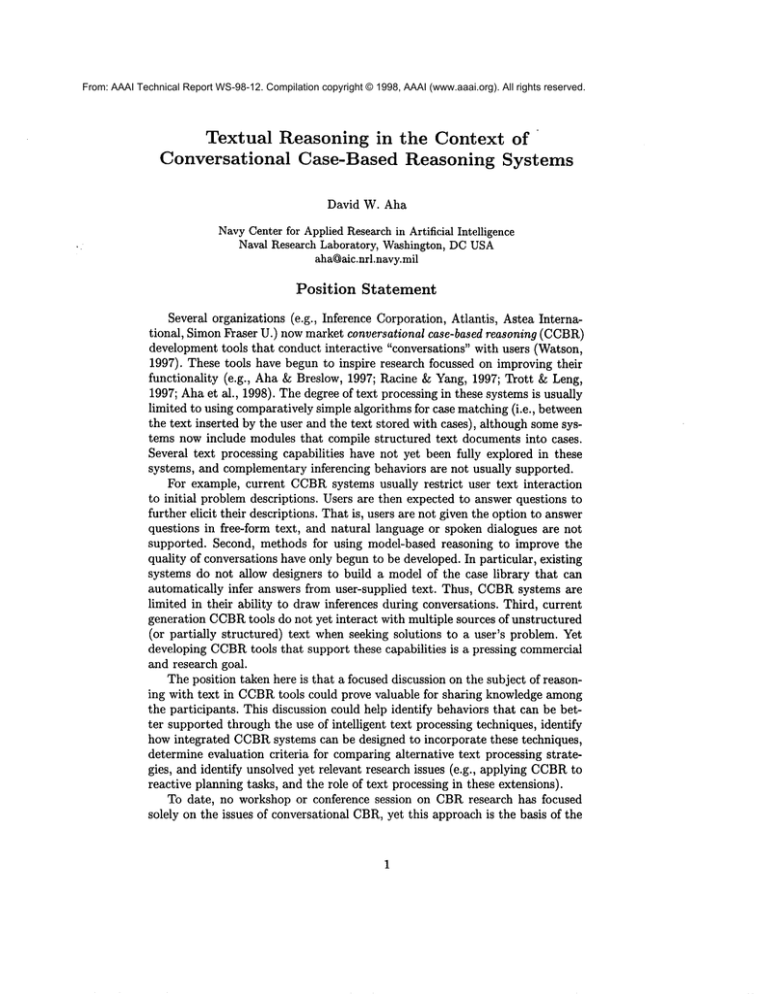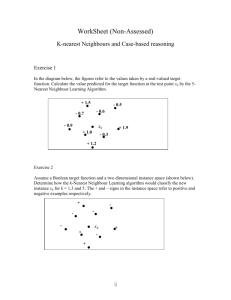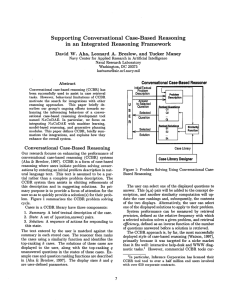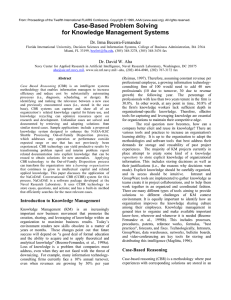
From: AAAI Technical Report WS-98-12. Compilation copyright © 1998, AAAI (www.aaai.org). All rights reserved.
Textual Reasoning in the Context of
Conversational
Case-Based
Reasoning Systems
David W. Aha
NavyCenter for AppliedResearchin Artificial Intelligence
Naval Research Laboratory, Washington, DCUSA
aha@aic.nrl.navy.mil
Position Statement
Several organizations (e.g., Inference Corporation, Atlantis, Astea International, SimonFraser U.) now market conversational case-based reasoning (CCBR)
development tools that conduct interactive "conversations" with users (Watson,
1997). These tools have begun to inspire research focussed on improving their
functionality (e.g., Aha & Breslow, 1997; Racine & Yang, 1997; Trott & Leng,
1997; Aha et al., 1998). The degree of text processing in these systems is usually
limited to using comparatively simple algorithms for case matching (i.e., between
the text inserted by the user and the text stored with cases), although somesystems now include modules that compile structured text documents into cases.
Several text processing capabilities have not yet been fully explored in these
systems, and complementary inferencing behaviors are not usually supported.
For example, current CCBRsystems usually restrict user text interaction
to initial problem descriptions. Users are then expected to answer questions to
further elicit their descriptions. That is, users are not given the option to answer
questions in free-form text, and natural language or spoken dialogues are not
supported. Second, methods for using model-based reasoning to improve the
quality of conversations have only begun to be developed. In particular, existing
systems do not allow designers to build a model of the case library that can
automatically infer answers from user-supplied text. Thus, CCBRsystems are
limited in their ability to draw inferences during conversations. Third, current
generation CCBRtools do not yet interact with multiple sources of unstructured
(or partially structured) text when seeking solutions to a user’s problem. Yet
developing CCBRtools that support these capabilities is a pressing commercial
and research goal.
The position taken here is that a focused discussion on the subject of reasoning with text in CCBRtools could prove valuable for sharing knowledge among
the participants. This discussion could help identify behaviors that can be better supported through the use of intelligent text processing techniques, identify
how integrated CCBRsystems can be designed to incorporate these techniques,
determine evaluation criteria for comparing alternative text processing strategies, and identify unsolved yet relevant research issues (e.g., applying CCBRto
reactive planning tasks, and the role of text processing in these extensions).
To date, no workshop or conference session on CBRresearch has focused
solely on the issues of conversational CBR,yet this approach is the basis of the
most successfully applied branch of CBRtechnology. Thus, a discussion focused
on this topic could enlighten attendees on the unique research issues that must
be addressed in conversational case-based reasoning, promote research on this
topic, and assist in developing ties between researchers and organizations that
are developing CCBRtools.
References
Aha, D. W., & Breslow, L. A. (1997). Refining conversational case libraries.
Proceedings of the Second International Conference on Case-Based Reasoning
(pp. 267-278). Providence, RI: Springer.
Aha, D. W., Breslow, L. A., & Maney, T. (1998). Supporting conversational
case-based reasoning in an integrated reasoning framework. In D.W. Aha &
J.J. Daniels (Eds.), AAAP98Workshop on Case-Based Reasoning Integrations
(Technical Report WS-97-04). Menlo Park, CA: AAAIPress.
Racine, K., &Yang, Q. (1997). Maintaining unstructured case bases. Proceedings
of the Second International Conference on Case-Based Reasoning (pp. 553-564).
Providence, RI: Springer.
Trott, J. R., & Leng, B. (1997). An engineering approach for troubleshooting
case bases. Proceedings of the Second International Conference on Case-Based
Reasoning (pp. 178-189). Providence, RI: Springer.
Watson, I. (1997). Applying Case-Based Reasoning: Techniques for Enterprise
Systems. San Francisco: Morgan Kaufmann.
This article was processed using the I~TEXmacropackage with LLNCS
style





